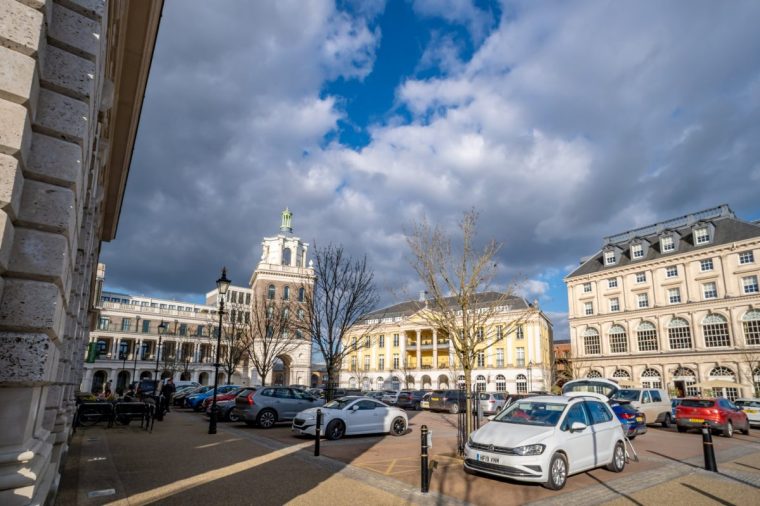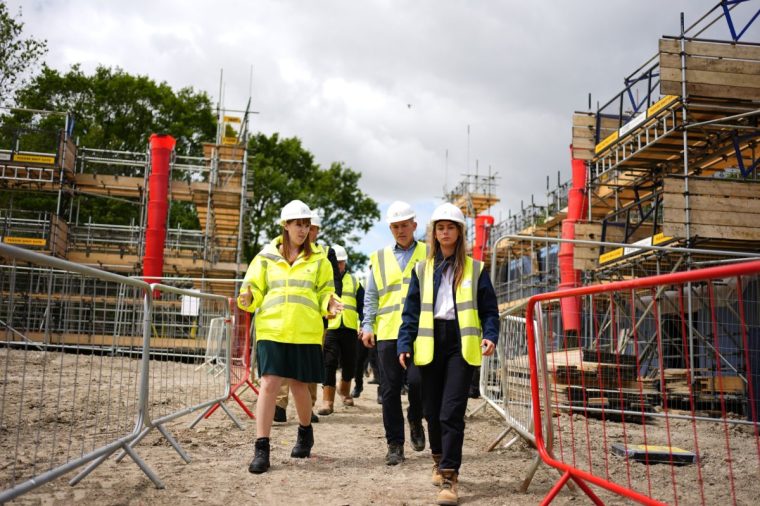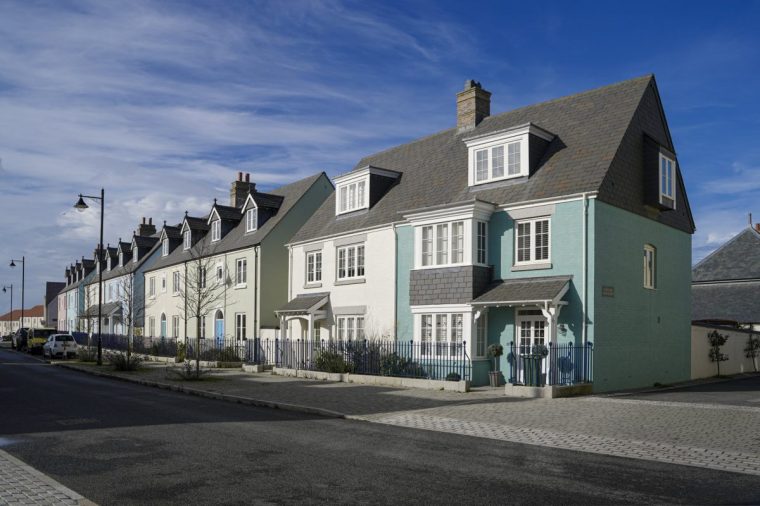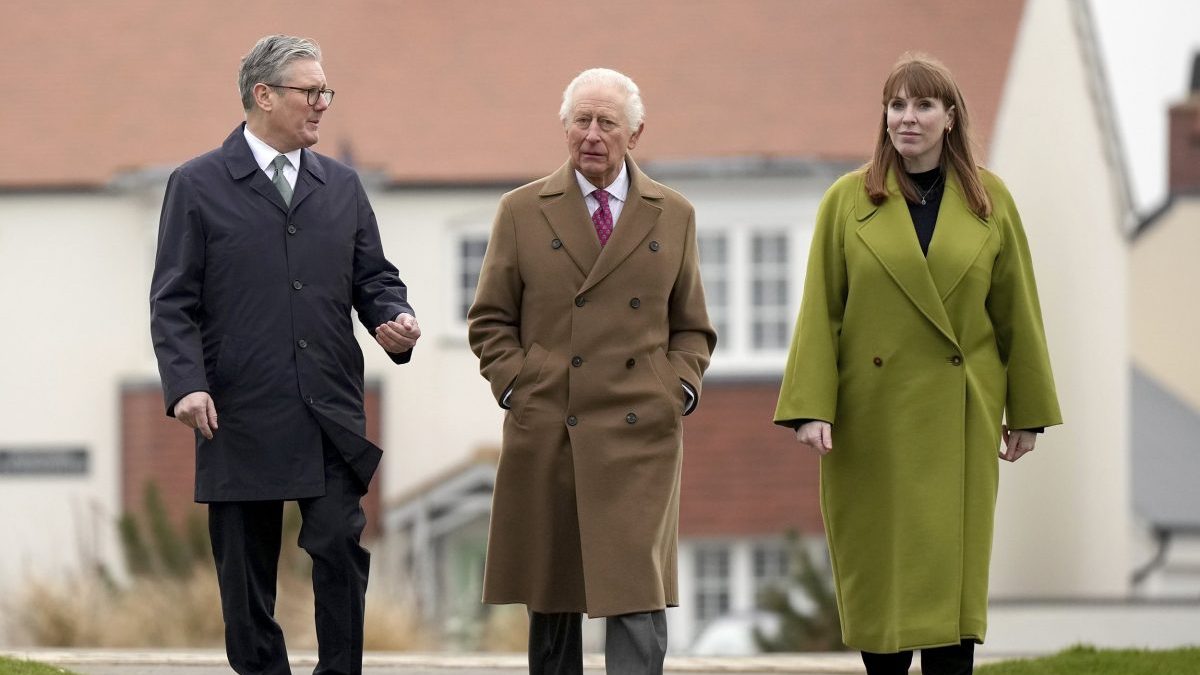Angela Rayner is an ardent royalist and has said she was influenced by King Charles’s ideas on housing design. But it looks increasingly unlikely that the Government’s mass building programme will create homes fit for a King.
The Deputy Prime Minister, who as Housing Secretary is responsible for overseeing Labour’s pledge to build a dozen new towns and create 1.5 million homes by 2029, is under fierce pressure to cut her departmental budget under a government spending review that could have major consequences for the biggest housebuilding programme since the Second World War.
When the King showed Rayner and Keir Starmer around the Duchy of Cornwall’s Nansledan extension to Newquay in Cornwall in February, it looked as if Charles was going to exert a huge amount of influence on the design of new towns and other developments across Britain in Labour’s rush to build.
After the visit, Rayner, revelling in the attention of the monarch, declined to comment on reports that she had described herself as the King’s “common friend”, and Starmer praised the principles underlying Nansledan, which is due to be a 4,000-home suburb of Newquay.
 Poundbury near Dorchester has been touted as one of the most successful developments in the UK thanks to the attractive architecture reflecting local character (Photo: Thomas Faull/Getty)
Poundbury near Dorchester has been touted as one of the most successful developments in the UK thanks to the attractive architecture reflecting local character (Photo: Thomas Faull/Getty)
“I was struck by the quality of the build, the variety, particularly struck by the fact that you couldn’t tell which was social housing,” he said. “It was really good quality.”
But despite reports that the new towns will be inspired by the King’s vision for sustainable communities, some of the big developers have warned that they may not have the money to provide homes to the same high specifications as those built on the Duchy’s land at Nansledan or other sites including Poundbury on the outskirts of Dorchester in Dorset. And others have questioned whether it is even a good idea to mimic the monarch’s model housing projects.
Where could new towns in the UK be built?
An influential report last week by WPI Strategy, a public affairs consultancy, estimated that a dozen new towns containing at least 10,000 homes and some with many more will cost up to £48 billion, between £3.5 billion and £4 billion each, with much of the initial investment coming from the taxpayer.
The authors – Paul Chamberlain and David Morris, two former economists in Rayner’s Ministry of Housing, Communities and Local Government – recommended that the new towns should be funded by government borrowing and long-term private sector capital in the form of debt or equity.
Their report, submitted to the Government and their independent, advisory New Towns Taskforce, suggested the best locations would be Milton Keynes, Leeds, South Gloucestershire, Central Bedfordshire, Wiltshire and Huntingdonshire, followed by West Northamptonshire, Mid Devon, South Cambridgeshire, Winchester, East Hertfordshire, and Northumberland.
The New Towns Taskforce is expected to publish their recommended shortlist for locations later this summer, and the King will be hoping that some of his ideas, such as creating walkable neighbourhoods built from local materials to create a low-carbon lifestyle, may still be reflected in the general design principles.
 Deputy Prime Minister Angela Rayner (left) is responsible for overseeing Labour’s pledge to build a dozen new towns and create 1.5 million homes by 2029 (Photo: Jordan Pettit/PA Wire)
Deputy Prime Minister Angela Rayner (left) is responsible for overseeing Labour’s pledge to build a dozen new towns and create 1.5 million homes by 2029 (Photo: Jordan Pettit/PA Wire)
But there may be much that does not translate from a royal estate, according to leading figures in the building industry. They worry they will not have the budgets to build properties up to the same standards as a Duchy of Cornwall development constructed on land provided cheaply or for free to showcase the then Prince of Wales’s ideas.
“It will partly depend on how much the land costs and what that leaves for other amenities,” said Steve Turner, executive director of the Home Builders Federation, whose members erect around 80 per cent of Britain’s new housing.
He added: “There are a thousand different permutations. It’s a lot easier if the land is provided for free. The higher the cost of the land, the less there is to spend on other things. It’s also to do with local attitudes and the needs of the local communities.”
Rico Wojtulewicz, head of policy and market insight at the National Federation of Builders, made similar points and also suggested that the King’s ideas, showcased at Poundbury as well as Nansledan and other developments, “are not everyone’s cup of tea”.
“There are lots of different ideas about how to do these things,” he said. “You’ve got 3,000 developers in the UK who are building for different markets. What works for Poundbury might not be right for a development in the north-east of England.”
He pointed to criticism of the cramped interiors of some houses at Poundbury, where residents complain that their garages are too small for modern cars and the Duchy seeks to enforce draconian rules preventing barbecues, washing on balconies, and controlling the colour of front doors.
What worked in the late 1980s and early 1990s when the plans for Poundbury were drawn up does not necessarily work now, they say.
Royal insiders have noted that the new Prince of Wales and Duke of Cornwall, William, has not visited Poundbury since inheriting the £1.3 billion Duchy estate when his father became King in 2022. “He doesn’t want anything to do with it,” one source claimed.
Rayner and Starmer have steered away from any overarching design, insisting instead that new developments might have a specific look depending on local attitudes. “A beautiful home is actually something quite hard to design, but well-designed and led by the community is important,” Starmer said after their visit to Nansledan.
Wojtulewicz predicts new town development corporations will be set up by the Government to acquire land by compulsory purchase and then recoup some of the cost to the public purse by selling it to developers. “They will probably charge more for the land than they paid, but it will be below the market rate,” he said.
He praised the Government for their ambitions but insisted there was no way it could hit its target of building 300,000 homes per year and 1.5 million homes by 2029.
 Nansledan is the second development whose architecture and urban planning is championed by King Charles (Photo: Hugh Hastings/Getty Images)
Nansledan is the second development whose architecture and urban planning is championed by King Charles (Photo: Hugh Hastings/Getty Images)
“I am predicting 300,000 homes a year by the end of the parliament,” he said. “I still think if they get to that, it will be an incredible amount and quite an achievement. At the moment, they are probably around 210,000 this year.”
Rayner, who has been demanding more cash for her department, faces a fight for her priorities with the Chancellor, amid a briefing war in which it has been suggested – and then denied – that she might even lose responsibility for housing.
Behind-the-scenes negotiations are expected to continue between ministers this week before a formal announcement on June 11 of a spending review setting departmental budgets for the next four years.
Inside Angela Rayner’s relationship with King Charles
Her reputation as a left-wing firebrand and her background as a care worker and trade union activist who left school at 16 while pregnant and without any qualifications means that her bonding with the King has been a source of fascination for many.
Some see her as the key representative reminding Labour of its traditional working class and pro-monarchy vote. She has been critical of Prince Andrew privately, like most Britons, but even at the height of Corbynism, she went on television to defend the Royal Family in 2017 after they were criticised by Emma Dent Coad, the then Labour MP for Kensington.
“They are a fantastic export. People love them across the world, and I think that they contribute to everything that’s British, and I don’t have a problem with the Royal Family,” she said.
The King, who has appeared charmed by her at their various public meetings, is said to have enjoyed his various meetings with Rayner and has worked closely with Rayner and Starmer.
“He gets on with politicians from all parties and enjoys their company,” one royal source said, but whereas his late mother enjoyed all of the Westminster gossip, his is a more earnest interest in sharing his views on policy. “It’s about the positions they hold,” the source added.
Starmer, perhaps more than any Prime Minister in recent history, has seen the value in the King’s soft power, notably his long friendship with Donald Trump, which has helped to improve his own relationship with the US President after a bumpy start.
Cynics suggested that his and Rayner’s trip to Cornwall in February, coming ahead of a big announcement about the government’s housing plans, was an attempt to use the King to make building over green fields across the country more acceptable, but the Government denied dragging the monarchy into party politics.
If and when Labour finally gets its act together on housing, the King may be privately disappointed if more of his ideas are not taken up but those close to him have insisted that his offer to show the Prime Minister and Deputy Prime Minister around Nansledan earlier this year was not an attempt to insert his ideas on government policy. “It was show, not tell,” one source said.
Will the new towns get the royal nod or face the ignominy of being labelled monstrous carbuncles? In his role as head of state, Charles is unlikely to be as outspoken as when he was Prince of Wales, so he will probably keep his thoughts to himself.
